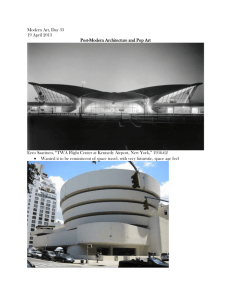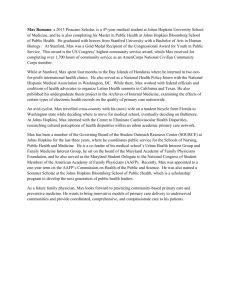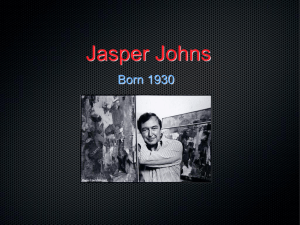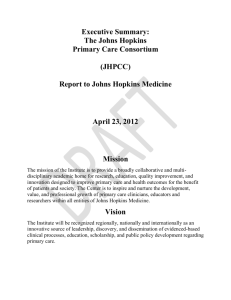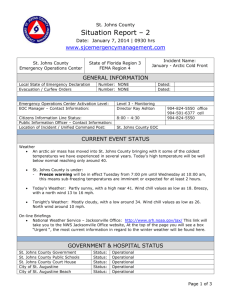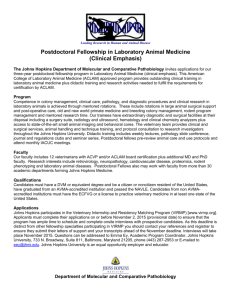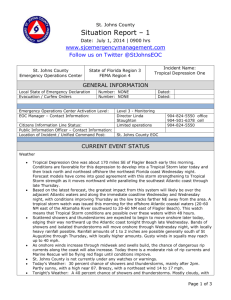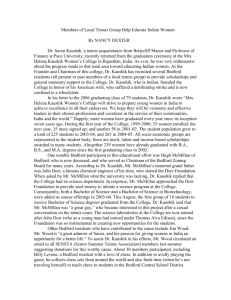atlas-johns-fy13-v4
advertisement
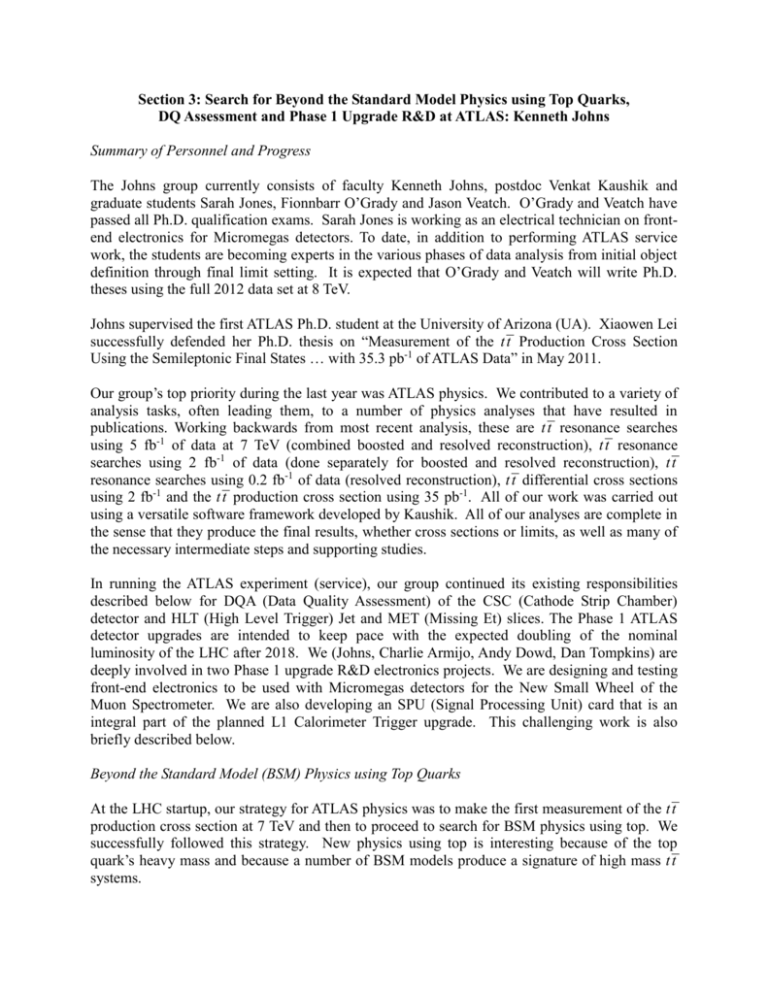
Section 3: Search for Beyond the Standard Model Physics using Top Quarks, DQ Assessment and Phase 1 Upgrade R&D at ATLAS: Kenneth Johns Summary of Personnel and Progress The Johns group currently consists of faculty Kenneth Johns, postdoc Venkat Kaushik and graduate students Sarah Jones, Fionnbarr O’Grady and Jason Veatch. O’Grady and Veatch have passed all Ph.D. qualification exams. Sarah Jones is working as an electrical technician on frontend electronics for Micromegas detectors. To date, in addition to performing ATLAS service work, the students are becoming experts in the various phases of data analysis from initial object definition through final limit setting. It is expected that O’Grady and Veatch will write Ph.D. theses using the full 2012 data set at 8 TeV. Johns supervised the first ATLAS Ph.D. student at the University of Arizona (UA). Xiaowen Lei successfully defended her Ph.D. thesis on “Measurement of the t t̄ Production Cross Section Using the Semileptonic Final States … with 35.3 pb-1 of ATLAS Data” in May 2011. Our group’s top priority during the last year was ATLAS physics. We contributed to a variety of analysis tasks, often leading them, to a number of physics analyses that have resulted in publications. Working backwards from most recent analysis, these are t t̄ resonance searches using 5 fb-1 of data at 7 TeV (combined boosted and resolved reconstruction), t t̄ resonance searches using 2 fb-1 of data (done separately for boosted and resolved reconstruction), t t̄ resonance searches using 0.2 fb-1 of data (resolved reconstruction), t t̄ differential cross sections using 2 fb-1 and the t t̄ production cross section using 35 pb-1. All of our work was carried out using a versatile software framework developed by Kaushik. All of our analyses are complete in the sense that they produce the final results, whether cross sections or limits, as well as many of the necessary intermediate steps and supporting studies. In running the ATLAS experiment (service), our group continued its existing responsibilities described below for DQA (Data Quality Assessment) of the CSC (Cathode Strip Chamber) detector and HLT (High Level Trigger) Jet and MET (Missing Et) slices. The Phase 1 ATLAS detector upgrades are intended to keep pace with the expected doubling of the nominal luminosity of the LHC after 2018. We (Johns, Charlie Armijo, Andy Dowd, Dan Tompkins) are deeply involved in two Phase 1 upgrade R&D electronics projects. We are designing and testing front-end electronics to be used with Micromegas detectors for the New Small Wheel of the Muon Spectrometer. We are also developing an SPU (Signal Processing Unit) card that is an integral part of the planned L1 Calorimeter Trigger upgrade. This challenging work is also briefly described below. Beyond the Standard Model (BSM) Physics using Top Quarks At the LHC startup, our strategy for ATLAS physics was to make the first measurement of the t t̄ production cross section at 7 TeV and then to proceed to search for BSM physics using top. We successfully followed this strategy. New physics using top is interesting because of the top quark’s heavy mass and because a number of BSM models produce a signature of high mass t t̄ systems. Our first analysis was measurement of the t t̄ production cross section using 35 pb-1 of data in the leptons plus jets channel. This work became the Ph.D. thesis of Lei. In order to separate the t t̄ signal from the W plus jets background, a top likelihood discriminant was constructed. The t t̄ cross section was then extracted via a binned maximum likelihood fit to the top likelihood distribution using templates for signal and background. The four variables chosen after extensive optimization were the ln(Centrality), exp(-11*Aplanarity), the pseudorapidity of the lepton and a binary variable corresponding to whether any jet was b-tagged in the event or not. All backgrounds were evaluated using Monte Carlo simulation, except for QCD which is estimated using the data-driven matrix method. Our final result was σ(t t̄ ) = 166 ±10(stat) ±32(syst) ±6(lumi) pb. We (Johns, Kaushik, Lei) contributed to cut flow validation challenges, produced expected values of signal and backgrounds, optimized variables for the top likelihood discriminant and evaluated many sources of systematic errors including the uncertainties associated with the jet energy scale (JES), ISR/FSR and pileup, which was a unique contribution from our group. We regularly contributed to the lepton plus jets top cross section subgroup meetings. However close to the finalization of the result, there was much political maneuvering on whether or not to include b-tagging and the minimum number of jets to include, among other things. We did not fare well in these machinations and our variables and method were not chosen for the eventual publication in Phys. Lett. B711 (2012) 244 [3-1]. We (Johns, Kaushik) next began work on searches for t t̄ resonances using the lepton plus jets decay channel. We made increasing contributions to a wide range of analysis tasks in t t̄ resonance searches using 200 pb-1, 2 fb-1 and currently 5 fb-1 of 7 TeV data. Two particular models serve as benchmarks since there are associated Monte Carlo generators and cross section predictions. The specific t t̄ resonances we presently seek to discover or exclude are a leptophobic topcolor Z’ boson [3-2] and a Kaluza-Klein (KK) gluon that is found in RandallSundrum models [3-3]. Starting with the 2 fb-1 analysis, we utilized both resolved and boosted t t̄ reconstruction techniques. In the resolved analysis, the hadronically decaying top is reconstructed using three anti-kt (R=0.4) jets. The boosted analysis on the other hand reconstructs the hadronically decaying as a single fat jet (an anti-kt jet with R = 1.0). Such fat jets are expected for larger values of m(t t̄ ) because of the boost received by the energetic top quarks. One of our (Johns, Kaushik) contributions to the 200 pb-1 search was participation in cut flow validation challenges. This involves ensuring the correct object definitions are used, the correct scale factors adjusting Monte Carlo to data are employed, the correct pile-up reweighting is applied and the correct procedures for determining systematic errors are adopted. In addition, we (Kaushik) pushed the use of a kinematic fitter called KLFitter to reconstruct the t t̄ invariant mass. While we did not develop KLFitter (from Erdmann et al. at the University of Gottingen) we helped validate the reconstruction and provided several bug-fixes in the core software and user interface [3-4]. The results were summarized in a Conference Note, ATLAS-CONF-2011087 [3-5]. We (Johns, Kaushik) made substantially more contributions to the resolved and boosted t t̄ resonance searches using 2 fb-1 of data. There were two separate analyses. For the resolved analysis, we (Kaushik) participated in the cut flow validation challenges and estimation of expected signal and background yields. We produced m(t t̄ ) spectra using both KLFitter and the dRmin reconstruction methods . Because of time pressure to publish, the KLFitter mass spectra were not used in the final limit setting. Partly for that reason, we (Johns, Kaushik) began to focus more on the boosted analysis. We (Kaushik) validated our boosted analysis by comparison of cut flow results and expected yields. We produced a wide selection of data/Monte Carlo comparison plots. We contributed many m(t t̄ ) spectra with systematic variations that were included for limit setting. We (Johns) also set limits using Bayesian, CLs (LEP) and CLs (profile likelihood) methods using RooStats. While the group decided to use a different Bayesian limit setting machinery (TopStat Bayes) our limits provided confirmation of the published result as well highlighted the effects of profiling on limit setting. Limits from both resolved and boosted analyses with using 2 fb-1 have been accepted for publication in EPJC and JHEP respective [36][3-7]. We continued to make significant contributions to the t t̄ resonance search with 5 fb-1. A dwhich is nearing ATLAS circulation. For this round, both resolved and boosted samples are combined into one analysis. We (Johns, Kaushik) did early studies of applying b-tagging in the boosted analysis to reduce the W plus jets background. We (Kaushik, Leone, Veatch) showed how to increase efficiency by adopting a large R jet trigger (as opposed to isolated lepton triggers) for event selection and optimizing the fat jet cuts. We (Kaushik, Veatch) validated our analysis in the usual way via cut flow count and expected yield challenges. Also noteworthy is the W plus jets data-driven scale factors produced by Kaushik needed to reduce the normalization uncertainty of this background in the boosted reconstruction data. We (Johns, O’Grady) also carried out a variety of limit calculations in support of the final result. Johns is co-editor of this paper and a draft Phys.Rev.D is nearing ATLAS circulation. Before focusing completely on t t̄ resonance searches, Kaushik made significant contributions to a related analysis, measurement of the t t̄ differential cross sections with respect to m(t t̄ ), Pt(t t̄ ) and y(t t̄ ). The measurements are an additional interesting way to search for deviations from the Standard Model. In this analysis, Kaushik carried out truth versus reconstruction studies in order to produce a response matrix for unfolding. He compared the bias and unfolding errors using different unfolding methods. He also compared the m(t t̄ ) spectrum for different reconstruction methods including KLFitter and produced the final measured m(t t̄ ) spectrum for unfolding. These results were submitted to EPJC (arXiv:1207.5644) [3-6]. Kaushik successfully assumed a leadership role as MET liaison to the Top Physics Group. The charge is to provide and validate a consistent MET definition for all top analyses. He developed MET validation tools based on loose, medium and tight isolation of leptons. He supervised efforts from volunteers to carry out performance studies. He was the primary author for the MET portion of the top reconstruction conference note written for Spring and Summer 2012 conferences. In order to expand our physics reach as well as quickly integrate Varnes, Lei and Nayyar into ATLAS data analysis, we identified several new top-related research avenues to follow using 8 TeV data. While the likely discovery of the Higgs boson rules out chiral fourth generation quarks, a list of possible vector-like quarks remains to be ruled out (or discovered) [3-7]. In particular, we (Johns, Kaushik, O’Grady) plan to search for fourth generation vector-like b quarks that decay into a WtWt final state using same-sign dileptons. We (Kaushik, Leone) are also investigating the feasibility of searching for T or T5/3 quarks using a dilepton signature. Of course, we (Johns, Kaushik, Veatch) have already started analyzing the 8 TeV data in order to extend the t t̄ resonance search as well. CSC DQA (Data Quality Assessment) In running the ATLAS experiment, one of our main responsibilities is online and offline Data Quality Assessment (DQA) software for the CSC (Cathode Strip Chamber) system. The software and procedures for these US-produced detectors were originally developed by Johns, Kaushik and Lei. O’Grady is now responsible for the online monitoring and Veatch for the offline monitoring. Histograms produced by the online CSC DQA software are used by control room shifters to quickly detect problems. Histograms produced by the offline CSC DQA software are used by the Muon DQ shifter in order to set a CSC DQ flag for each run, which may later be used to include or exclude runs for a given physics analysis. In the last year we (O’Grady, Veatch) continued to improve the monitoring for both online and offline CSC DQA. For example, to increase the probability that we are monitoring muons from collisions (as opposed to photon or neutron background) both online and offline monitoring software only use CSC charge clusters that lie on quality segments. Also, chamber occupancies and segment efficiencies are now monitored as a function of luminosity block (roughly 2 minute intervals) to more quickly identify changes. We (Johns, Jones, Leone) also have an ongoing effort to extract CSC calibration constants using data, which we hope can improve the muon momentum resolution of very high Pt forward muons. HLT Jet and MET Trigger Slice DQA In running the ATLAS experiment, we continue to hold responsibility for HLT Jet and MET (Missing Et) DQA. These are two completely independent tasks that are combined into one here for the sake of brevity. HLT means High Level Trigger and refers to both the L2 (Level 2) and EF (Event Filter) stages. Johns concentrates on the online monitoring software while Kaushik focuses on the offline monitoring software. In the last year, we continued to develop and maintain DQA software for both online and offline shifters for HLT Jet and MET slices. Histograms are used by both general trigger shifters as well as by Jet and MET slice trigger shifters to quickly detect problems in the data. There is also an automatic DQA, which is done through various DQ flag algorithms in DQMF. Both the online and offline monitoring software was updated and improved for the 2012 run. New Jet and MET triggers in the Physics Menu were added and improved DQ flag algorithms were developed. An additional responsibility we have is maintain macros for the online (OHP) and offline (DQMD and HAN) display software. Micromegas Front-End Electronics for the New Small Wheel We (Johns, Jones, Tompkins, Veatch) are very active in developing Micromegas detector technology for ATLAS. The main limitations of the existing Small Wheel in ATLAS are large L1 muon trigger rates due to fakes that increase with luminosity and compromised tracking performance. The ATLAS muon group proposed that the New Small Wheel be comprised of Micromegas detectors for precision tracking and Thin Gap Chambers for triggering. We have been a member of the MAMMA (Muon ATLAS MicroMegas Activity) since 2007 and helped develop Micromegas technology for ATLAS through numerous test beam campaigns and subsequent data analysis. The test beam campaigns were used to evolve Micromegas technology for colliding beam use included evaluating different detector designs and operating conditions (TPC mode, different gases, resistive strips, 2D readout, …). Some results are documented in [3-8]. In the last year, the development of front-end and readout electronics for Micromegas, rather than improvements in chamber design and capability, became our focus. The front-end electronics we designed is built around a peak-finding (amplitude and time) ASIC (Application Specific Integrated Circuit) developed by BNL. For 2012, an analog-only ASIC (called the VMM1) designed to operate with Micromegas was produced by BNL and is currently being evaluated by us during 2012 test beam runs at CERN. Very preliminary results show the chip to be performing as expected in both its precision tracking and trigger capabilities. The primary board we (Johns, Tompkins) designed and tested is called the Mini. The Mini is a front-end card using one 64-channel VMM1 ASIC intended for use with eight prototype 10cm x 10cm Micromegas detectors in the 2012 test beam setup. The outputs of the Mini cards are analog signals that must be subsequently digitized. We also designed several adapter boards that were used to assemble a digitization and readout system at the last moment in collaboration with BNL and Harvard. (Previously we had designed and tested a digitation and readout card for use in the CERN Scaleable Readout System but the unexpected death of Steinberg and lack of associated electronics at CERN meant we had to devise an alternative). We are currently in the process of analyzing both the tracking and trigger test beam data produced by the VMM1. Development of an SPU (Signal Processing Unit) for the L1 Calorimeter Trigger Upgrade Another R&D area in the Johns group is the development of the SPU (Signal Processing Unit) card for a Phase 1 upgrade of the L1 Calorimeter Trigger for LAr. To keep pace with the increase in LHC luminosity beyond 2018, the L1 trigger rates for electrons and jets must be reduced by improving the resolution of these objects. New electronics, starting with new LTDB’s (LAr Trigger Digitizer Boards) will receive higher granularity (in ) signals from new Layer Sum Boards, digitize them on-detector, and then send the data via high-speed optical links (at perhaps 10 Gbps) to a new DPS (Digital Processing System) [3-9]. The SPU cards are the functional units of the DPS receive the high-speed signals and perform digital signal processing in order to determine the transverse energy of the calorimeter pulses. The SPU subsequently sends this refined information to the Feature Extractor of the L1 Calorimeter Trigger, again by high-speed optical links. This research area is also very relevant for proposed a Phase 2 upgrade where all LAr Front-End Boards (FEB’s) will be replaced with fully digital ones and readout by SPU/DPS-like electronics. Our (Johns, Dowd, Armijo) research has been to focus on the development of the SPU card. This is one area that our contributions particularly suffered in the wake of the loss of Joel Steinberg and we now collaborate with BNL and Stony Brook University on this project to increase our strength. The SPU card is an AMC (Advanced Mezzanine Card) format card designed for use in a telecommunications standard ATCA (Advanced Telecommunications Computing Architecture) platform. Two areas in which we are most active are the creation of firmware for the DSP processing and other functions required of the SPU card and evaluation of commercial high speed optics for use in SPU I/O. In firmware, our goal is to develop a complete, functional chain from input to output for one channel including SERDES (serialization and deserialization), buffering, monitoring and signal processing. To date, we implemented a five-tap FIR (Finite Impulse Response) filter in the Xilinx 7 series of FPGA’s (Field Programmable Gate Arrays). We also implemented the buffering required to send data to the FEX (immediately) and TDAQ (pending L1 Accept). Timing and resources are evaluated using Xilinx ISE tools. The current latency is 50 ns which can be reduced to less than 25 ns in the future. We showed there are sufficient resources to expand these designs to 320 channels. Johns is currently the leader of the working group in ATLAS LAr to establish the firmware specifications for the SPU and the ATCA blades. Previously we designed an SPU-like card that made use of use of tiny “Optical Engines” from Reflex Photonics that mounted directly to the PCB. However this vendor proved unreliable and we are now in the process of evaluating MicroPOD embedded transceivers from Avago. We investigate and test the necessary high density and high bandwidth FPGA and optical transceiver technologies through the use of vendor evaluation boards and test firmware written by us (for Bit Error Rate Tests (BERT) e.g.). Future Plans Something about ttbar resonance search at 8 TeV Something about fourth generation down-type quark search at 8 TeV Something about fourth generation up-type quark search at 8 TeV Continue responsibility for HLT Jet and MET slice and CSC online and offline DQA until the LHC shutdown Participate in CSC maintenance during the LHC shutdown Complete data analysis of the trigger and tracking data from the VMM1 collected during 2012 test beam running Design and test multi-chip front-end cards for production size Micromegas for the NSW (these front-end cards will use the planned fully digital VMM2 ASIC from BNL) Investigate the use of CERN GBT (GigaBit Transceivers) for use in configuring and collecting trigger and tracking data from the front-end cards Continue to specify and develop the entire firmware chain required for the (SPU) Signal Processing Unit card Begin electrical design of a prototype SPU card (in collaboration with BNL and Stony Brook), focusing on the high speed optics Increase our efforts to produce simulated calorimeter signal waveforms including pileup of 50-200 events
